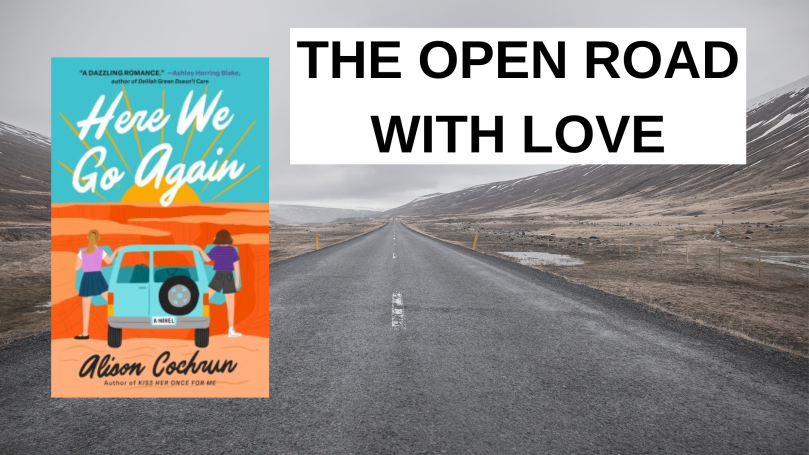I absolutely love road trips. I am happy to get in the car and drive 13 to 14 hours to go and visit my daughter and granddaughter in Indiana. I’m pretty happy to get in a car and drive almost anywhere. And I also love good books about road trips, like The Mostly True Adventures of Tanner and Louise, and everyone knows I love a good romantic comedy. So when you have a romantic comedy about a road trip, you’re in my sweet spot, which is why I loved Here We Go Again, by Alison Cochrun, so much.
Actually, there’s a lot to love about this book. It’s funny, it’s charming, it’s moving and in many ways it’s surprising (all good ways, I might add). The characters are lovable (for the most part; there are some you’re not supposed to love, and that’s fine, too), the plot moves right along, and there are none of those rom com cliches (especially about how the couple breaks up and finds their way back together) that annoy me so much. It even starts with a couple of very funny (and painful) disasters to introduce our main characters (I always like a rom com that starts out with a funny scene).
Logan and Rosemary are both teachers at the local high school. They are also enemies. Once upon a time, when they were growing up in the town where they’re both now working, they were the closest of friends, and on the verge of becoming more than friends when everything blew up for them. When they were both in high school, they took English classes from Joe Delgado, a legendary teacher who saw the strengths in each of them even when they were loudly opposed to each other. Joe was gay and out, and his acceptance of his own sexual identity made it easier for each of the girls to admit to her own queerness.
But now Joe is dying of cancer, and he asks both Logan and Rosemary to take him on one last road trip, to a cabin he owns on Mount Desert Island in Maine (they’re starting out in Washington State). Though neither one wants to spend a lot of time in a car together, they both feel such an obligation to Joe that they agree to do it. And off they go, on a cross-country adventure that takes up most of the book.
There are some things you know from the outset: Joe is going to die by the end of the book (this isn’t the kind of book that has a miraculous recovery), and Logan and Rosemary are going to end up together by the end of the book.
The fun of the book is watching how Logan and Rosemary get together, and discovering both new things about Joe (including the love of his life), and wonderful things about America. I’m a little bummed that their trip up the east coast is covered in a page or so, though I understand why it happened that way. On the other hand, their side trip to the Grand Canyon, their overnight stay in Idaho (which turns out to be surprising) and their sojourn in Ocean Springs, Mississippi, are wonderful, making me want to travel to all those places and experience them for myself.
There’s sadness in this book, of course – I did mention that Joe’s dying, didn’t I? – but it’s a romantic comedy and so yes, there’s a happy ending, a soul-satisfying happy ending for all the characters you’ve come to care about.
The next best thing to a road trip is a great road trip book. Here We Go Again definitely qualifies.


